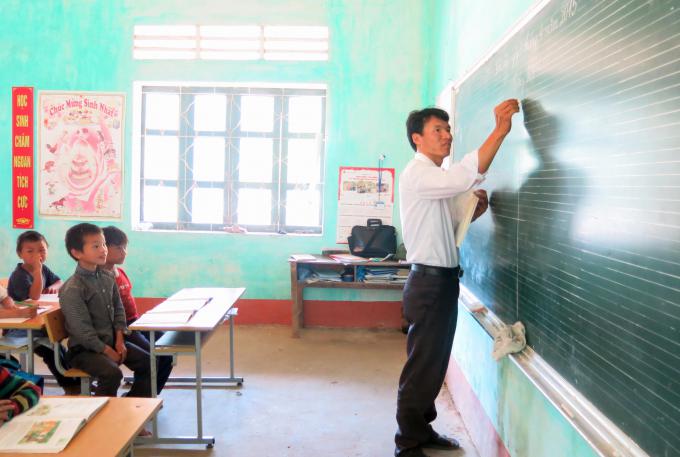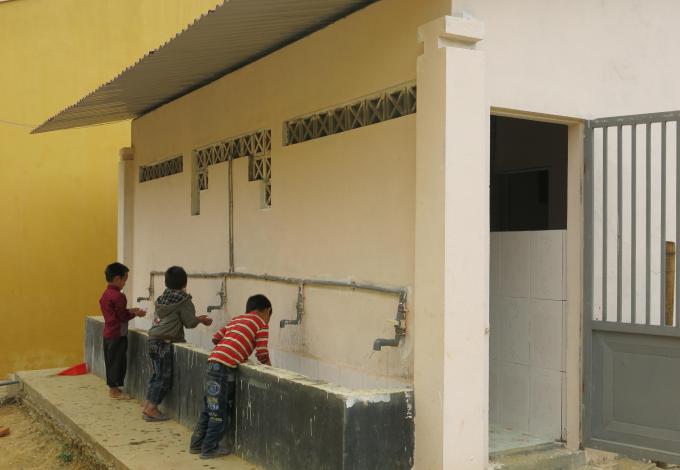Su’s Story: My Joy as a Teacher for Hmong Children
When Vang A Su first tried applying the child-focused teaching method that encourages students’ active participation in class, it turned out to be harder than he had expected. His students, who were familiar with the traditional teacher-centered method, had little idea about group discussion or group work. They didn’t know what they were supposed to do while he found it hard to “activate” his students.
“Our classes used to be quiet because our teaching methods were sometimes boring and even inappropriate to our students,” said Su, a teacher at Tu Thuong satellite primary school in Lao Cai province, recalling the days he used the teacher-centered method and when he first applied the new one. “Now we try to maximize the use of visual aids, especially pictures and objects to make the lesson content imaginable for our students.”
Save the Children’s Sponsorship Program has been supporting teachers like Su by providing training on new teaching methods, on book production and supplying them with teaching-learning materials. Through training courses, Su and other teachers picked up techniques to encourage their students in class activities. The training courses, which take up to a few days, can be integrated into the local Education Department’s plan. Parents and students are also involved in some trainings on book production and home learning environment.
.
“It’s a great idea to involve children in book production activities. It’s a good way to improve their imagination, Vietnamese vocabulary and communication skills. At the same time, we will have more teaching and learning materials,” said Su, 40, of Hmong minority group.
He has also been trying to localize the curriculum, integrating the local culture and children’s daily life activities into his lessons. His lessons thus make better sense to his students.
Su is among tens of thousands of teachers based in Vietnam’s remote mountainous areas where life is much harder than in the urban lowlands. It takes an hour and a half to travel by car or motorbike from the township, then another half an hour to go up the mountain on a winding pathway to his school. His students’ families are living with an average income at half of that in the Red River Delta. The stunting rate among ethnic minority children is hovering at 52 percent, far higher than the 14 percent rate among the Kinh majority group.
Language is also a major barrier. Vietnamese is used as the official teaching language, but many ethnic minority students do not speak the language. Su, fortunately of Hmong ethnicity like his students, uses Hmong language to teach his lessons. However, for most of the teachers in his school who do not speak their students’ language, it is a hard job.
Hygiene is another issue in the local area. Latrines are in poor condition. The latrine in Su’s school was made of wooden planks put over a stream, which was dangerous for children. It had neither water nor soap, nor separate rooms for boys and girls. In 2014, the Sponsorship Program built a new latrine for the school, which delighted Su and his students. It also helped to promote a hygiene habit among the students.
One of the largest projects that Save the Children in Vietnam is running, the Sponsorship Program facilitates children’s education via teacher training, building child-friendly libraries with learning materials and equipment, new classrooms, community libraries and supporting schools and communities to organize the “Family Learning Day.”
The program also supports children’s school health and nutrition by building new or upgrading latrine and hand-washing facilities, supporting schools to provide nutritious lunches to children, upgrading school yards to ensure child safety, and help schools and communities to organize communication events on injury prevention, oral health and personal hygiene.
The program’s support has contributed to better teaching and learning quality at his school, Su said. It’s inspiring to see his students go to school with joy. Su is delighted with his 15 years working as a teacher with Hmong students in his birthplace.
“I love this job,” he said. “I’m happy to have chosen it.”
 Vietnam
Vietnam 
